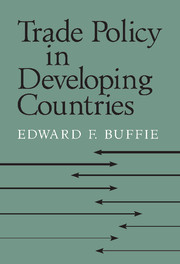Book contents
- Frontmatter
- Contents
- 1 Introduction
- 2 Tools and Tricks of the Trade, Part I: Duality Theory
- 3 The Trade Policy Debate
- 4 Tools and Tricks of the Trade, Part II: Linear Differential Equations and Dynamic Optimization
- 5 Underemployment, Underinvestment, and Optimal Trade Policy
- 6 Liberalization and the Transition Problem, Part I: Transitory Unemployment
- 7 Tools and Tricks of the Trade, Part III: The Dynamics of Temporary Shocks
- 8 Liberalization and the Transition Problem, Part II: Credibility and the Balance of Payments
- 9 Direct Foreign Investment, Economic Development, and Welfare
- 10 Suggestions for Future Research
- References
- Index
2 - Tools and Tricks of the Trade, Part I: Duality Theory
Published online by Cambridge University Press: 29 July 2009
- Frontmatter
- Contents
- 1 Introduction
- 2 Tools and Tricks of the Trade, Part I: Duality Theory
- 3 The Trade Policy Debate
- 4 Tools and Tricks of the Trade, Part II: Linear Differential Equations and Dynamic Optimization
- 5 Underemployment, Underinvestment, and Optimal Trade Policy
- 6 Liberalization and the Transition Problem, Part I: Transitory Unemployment
- 7 Tools and Tricks of the Trade, Part III: The Dynamics of Temporary Shocks
- 8 Liberalization and the Transition Problem, Part II: Credibility and the Balance of Payments
- 9 Direct Foreign Investment, Economic Development, and Welfare
- 10 Suggestions for Future Research
- References
- Index
Summary
Many policy issues in development economics cannot be addressed in a rigorous manner without building models that allow for considerable structural detail. Depending on the issue, it may be important to distinguish between agriculture and industry, between importable, exportable, and nontraded goods, between employment in high-wage vs. low-wage sectors, between domestically produced and imported capital goods, or between private and parastatal production. Unfortunately, there is a basic problem with the generally laudable strategy of including all relevant structural detail in a model: the more complicated the economic interactions, the messier the analysis and the more difficult it is to derive clean, insightful results. This is why duality theory should be part of the policy-oriented development economist's tool kit. Duality theory provides the model builder with functions based on the solutions to various static optimization problems. The functions summarize in a compact manner how demand and supply depend on preferences, technology, and optimizing behavior on the part of competitive, price-taking firms and consumers. This enables multisector general equilibrium models to be specified and manipulated with comparative ease as it is not necessary to explicitly solve the optimization problems that govern private agents' behavior. When duality theory is used to characterize demand and supply responses, general comparative statics results can be derived directly by exploiting the properties of the relevant maximum or minimum value functions.
Duality Theory and Supply
I start by discussing the duality functions that describe production and supply.
Information
- Type
- Chapter
- Information
- Trade Policy in Developing Countries , pp. 8 - 29Publisher: Cambridge University PressPrint publication year: 2001
